Computer systems we use today are of the fifth generation powered by artificial intelligence and ULSI (Ultra Large Scale Integration) technologies. They are quite intelligent and capable of carrying out an array of tasks. As familiar as we are with these smart systems, have you ever wondered how the first generation of computers were?
The first-generation computers were gigantic, covering an entire room, and performing arithmetic operations and calculations was their sole task. Their history dates back to the 1940s when computers were rarely used, unlike the current era where they have become a necessity.
With technological breakthroughs, the early computing devices have evolved into more sophisticated and intelligent marvels that we use every day in this era.
In this blog post, let us discuss the beginning of computer technology, i.e., the first generation of computers. We will walk you through the origins and architecture of computer systems.
First Generation of Computer: Overview
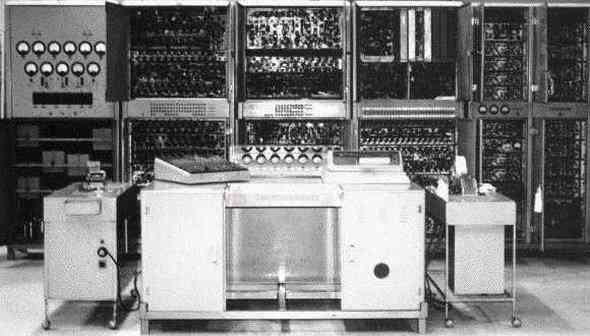
The first generation of computers refers to the era spanning from 1946 to 1959. All computers developed in this timeframe used vacuum tubes as their core technology.
Vacuum tubes were used for a variety of tasks, such as providing circuitry to the central processing unit (CPU), amplifying signals, serving as switching elements, and performing calculations.
First-generation computers were heavy due to their colossal size, spaced over an entire room. They had huge humming motors and belts connected to multiple switches and wires. Hence, there was a requirement for a large amount of electricity.
Furthermore, they were not reliable for programming tasks. Calculations, storage, and control were the major uses of first-generation computers. They leveraged punch cards as input devices , paper tapes as output devices , and magnetic tapes as memory devices.
- Punch Cards: A punch card is a stiff paper that stores digital information, which is represented by the presence and absence of holes. Many early computers used punch cards as input devices. They had a card reader to hold a punch card, which converted the holes into digital information.
- Paper Tapes: A paper tape also uses the same technology as a punch card. It is a long paper strip with the presence and absence of holes representing digital data. It was a slow, low-capacity, and sequential data storage device.
- Magnetic Tapes: A magnetic tape is a magnetic storage medium consisting of a long, narrow strip of plastic film with a magnetized coating. It stores audio, video, and other data.
ENIAC, UNIVAC, EDVAC, IBM-701, IBM-650, and Manchester Mark1, Mark2, Mark 3, etc., were popular examples of the first generation of computers.
What is a Vacuum Tube?
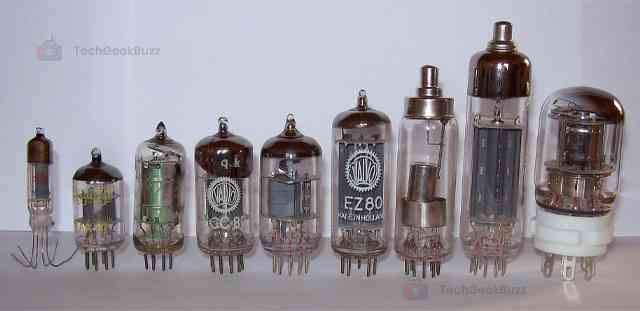
A vacuum tube is an electronic device, electron tube, or valve that controls the flow of electric current between electrodes in a high vacuum. In other words, it is a sealed glass tube creating a vacuum and controlling the flow of electric current.
In 1904, an English physicist, John Ambrose Fleming, created a vacuum tube, an indispensable aspect of electronic devices until the first half of the 20th century. It is the predecessor of modern transistors.
A vacuum tube consists of electrodes – a cathode that generates electrons and an anode that collects electrons. Initially, vacuum tubes were classified based on the number of electrodes they contained.
The electrodes are then enclosed in a sealed glass tube or container by removing all air, as air acts as a conductor serving as a pathway for electrons.
Earlier, vacuum tubes used a heating filament to generate electrons, which required an excess amount of electricity. This resulted in the generation of high amount of heat.
Characteristics of First-Generation Computers
Let us now throw light on the major features of the first generation of computers.
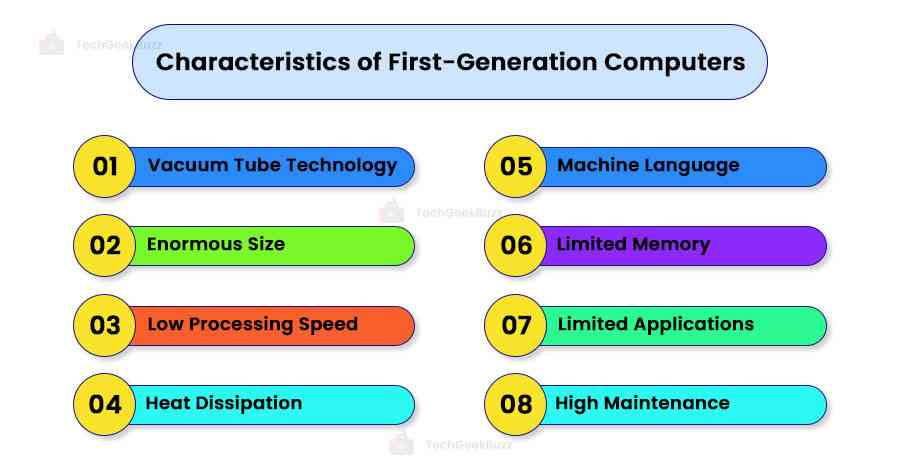
-
Vacuum Tube Technology
As discussed above, first-generation computers leveraged vacuum tubes as their primary technology. These tubes were very large and required a high amount of electricity. They primarily served as switches and amplifiers in the first generation of computers.
-
Enormous Size
The first-generation computers occupied almost an entire room. This is because they were composed of thousands of vacuum tubes, which were very large in size. In addition, they featured many other components, including power supplies.
-
Low Processing Speed
Early computers had extremely low processing speeds. They were capable of executing a few hundred instructions per second. In contrast, modern computers can execute billions to trillions of instructions in a second.
-
Machine Language
First-generation computers used machine language, which is the lowest level of programming language . It requires instructions in the form of binary code, i.e., 1s and 0s. This language is easier to understand for computers, as it is closely connected with their hardware.
Hence, providing instructions to first-generation computers required an in-depth understanding of the inner workings of computers. Additionally, writing a program in machine language was very intimidating and could result in errors.
-
Heat Dissipation
As discussed earlier, the first generation of computers used thousands of vacuum tubes, which were glass devices and served as switches and amplifiers. They were major components that performed calculations and stored data.
Unfortunately, vacuum tubes required excessive power and generated considerable heat. High heat dissipation resulted in several issues –
- The requirement of a large cooling system, which consumed a lot of space.
- Increased risk of component failures, which often led to downtime.
- High power consumption resulted in increased costs.
-
Limited Memory
Magnetic tapes were the storage devices used by the first generation of computers to store data. However, their storage capacity was extremely limited compared to today’s storage devices. Kilobytes, or sometimes even bytes, were the units to measure computers’ memory.
-
Limited Applications
The sole purpose of these computers was to perform calculations and store data. Hence, they could not handle complex or multiple tasks simultaneously. Their simple design and low processing power were major causes of their limited applications.
-
High Maintenance
Vacuum tubes are glass devices that are delicate and fragile. As a result, they would generally fail or malfunction in case of excess heat dissipation. They needed to be replaced to avoid computer downtime.
Advantages and Disadvantages of the First Generation of Computers
Here are some remarkable advantages and major disadvantages of the first generation of computers:
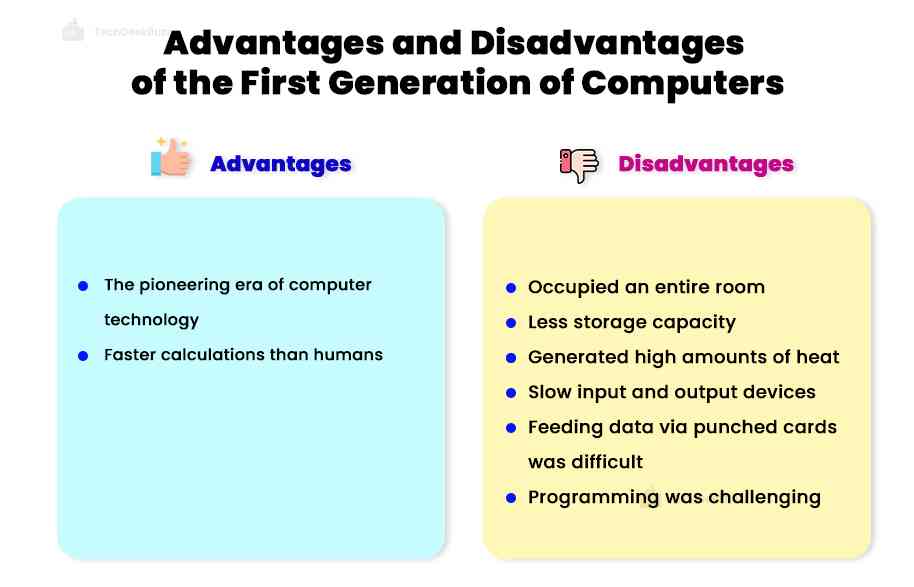
Advantages
- The first generation of computers was the pioneering era of computer technology.
- Though these computers were much slower than other generations, they performed calculations faster than humans.
Disadvantages
- These computers were huge, occupying an entire room. Hence, they were not portable.
- They had very less storage capacity because they used magnetic tapes.
- They dissipated high amounts of heat. Hence, they required a dedicated cooling system.
- The input and output devices (punched cards and punched tapes) were very slow.
- The process of feeding input to computers via punched cards was challenging.
- These computers used machine language, which was difficult for programmers to learn, understand, and program.
Examples of the First Generation of Computers
Here are the popular examples of the first generation of computers.
1. ENIAC: The First General-Purpose Computer

ENIAC stands for Electronic Numerical Integrator and Computer. It was the first general-purpose, programmable electronic computer designed by William Mauchly and John Eckert. The project started in 1942 at the University of Pennsylvania's Moore School of Electrical Engineering and was completed in 1945.
Characteristics of ENIAC
-
Architecture
ENIAC was terribly huge, consisting of 18,000 vacuum tubes. Its size was approximately 8 ft × 3 ft × 100 ft (2 m × 1 m × 30 m), consumed 1,800 sq ft (170 m2) areas, and weighed between 27 and 30 tonnes. Additionally, it required 150 kW of electricity. Wasn’t it incredibly large?
Besides vacuum tubes, it consisted of 10,000 capacitors, 1,500 relays, 70,000 transistors, 7,200 crystal diodes, and around 5,000,000 hand-soldered joints.
-
Purpose
The primary purpose of designing this computer was the military purpose. It was used by the US Army’s trajectory research lab to calculate artillery firing tables. It assisted the North American country troops in World War II.
-
Speed
ENIAC was the fastest computer of all other computers and mechanical machines at that time. It could perform 5,000 additions or subtractions in a second. More interestingly, it was decimal and not binary. Hence, it performed calculations on decimal numbers.
Furthermore, it featured 20 ten-digit signed accumulators, which could be combined to speed up operations.
-
Programmability
ENIAC was a programmable computer capable of carrying out complex operations, including loops, branches, and subroutines. Unlike modern computers with stored programs, ENIAC was simply a large combination of arithmetic machines. It already had programs set up using a combination of plugboard wiring and three portable function tables.
Drawbacks of ENIAC
- The major drawback of ENIAC was manual programming, which took time and effort.
- ENIAC was not able to store programs or instructions in its memory.
- Its large size required a considerable amount of electricity and generated high heat.
- Vacuum tubes required replacements in case of failure to avoid downtime.
2. UNIVAC I: The First Commercial Electronic Computer
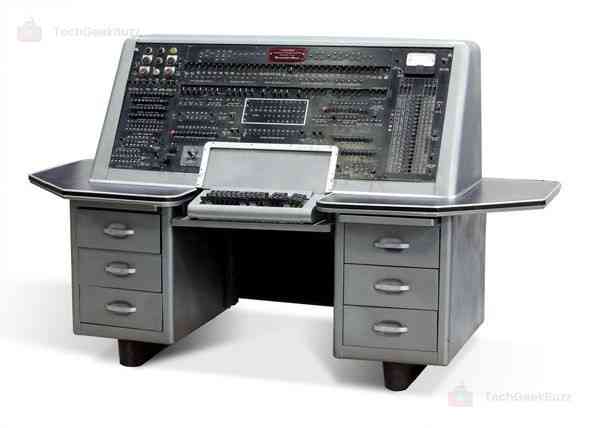
UNIVAC I is an acronym for Universal Automatic Computer I. It was the first general-purpose, commercial electronic computer. J. Presper Eckert and John Mauchly, inventors of ENIAC, designed UNIVAC. It was entirely dedicated to the United States Census Bureau.
Characteristics of UNIVAC I
-
Architecture
UNIVAC I was considerably smaller in size than ENIAC. It comprised 5,000 vacuum tubes and weighed 8.3 tonnes. It consumed 125 kW of power and performed around 1,905 operations per second.
This computer’s only processor and memory unit measured 4.3 m by 2.4 m by 2.6 m high. However, the entire system occupied over 35.5 m2 (382 ft²).
-
Stored-Program
UNIVAC I was a stored-program computer. This implies it could store programs and instructions in its memory and execute them sequentially, resulting in efficient programming, unlike ENIAC.
-
Commercial Use
UNIVAC I was the first computer used for commercial purposes in diverse fields, such as business, government, and scientific research.
-
1000-Word Memory
This computer had a main memory of 1000 words of 12 characters each. It consisted of 100 channels of 10-word mercury delay-line registers. The input/output buffers were 60 words each, comprising 12 channels of 10-word mercury delay-line registers.
-
Instructions and Data
Each instruction consisted of six alphanumeric characters and each work contains two instructions. UNIVAC I took 525 microseconds for addition and 2150 microseconds for multiplication.
Drawbacks of UNIVAC I
- Though UNIVAC I was smaller in size than ENIAC, it required more space than modern computers.
- It was very expensive, and only large organizations would afford it.
- UNIVAC I also consumed a substantial amount of electricity.
- Heat generation was very high. Hence, a cooling system was a must.
- Memory was limited compared to modern computers.
Conclusion
This was all about the first generation of computers. They utilized thousands of vacuum tubes, resulting in their enormous size and considerable heat generation. Unlike modern computers, they did not have a large storage capacity and processing speed.
Despite the disadvantages, we cannot neglect the fact that first-generation computers, like ENIAC and UNIVAC, were the trailblazers of computing technology.
People are also reading:


![What is an Assembler? [Definition, Working, & Types]](/media/new_post_images/What_is_Assembler.jpg)
![What is I/O? [Types, Examples, & Methods]](/media/new_post_images/What_is_I_O.webp)

Leave a Comment on this Post